Cookies, Candies and other confections from Piedmont
Following up on our article about the Historic cafés of Turin, we will continue our Turin and Piedmont tour with the extraordinary legacy of delicious cookies, cakes and chocolates of Piemontese origin.
Centuries of contact with the royal houses of France and Spain combined with a local savoir-faire explains why the Piedmont region, and more specifically Turin (once the capital of the composite state of the House of Savoy), have such a legacy of pastry-making and confectionery.
It is in Turin that, around the 1650s, Italian chocolate originates, patronized by the royal family. At the center of the Piedmontese candy and chocolate industry, Turin is not only the first capital of the unified Kingdom of Italy, but also the capital of chocolate. Piedmontese delicacies include colorful candies, almond cookies, creamy desserts, gianduiotti and candied violets.
Amaretti
 These little biscuits originated in Medieval Italy. They are common in various regions of Italy, but in Piedmont the most famous ones are from Gavi, Oveda and Mombaruzzo.
These little biscuits originated in Medieval Italy. They are common in various regions of Italy, but in Piedmont the most famous ones are from Gavi, Oveda and Mombaruzzo.
There are two types of Amaretti: soft (morbidi) and dry (secchi). They are made with sweet and bitter almonds, sugar and egg-whites. Some – such as the Amaretti from Mombaruzzo – also contain apricot seeds.
Amaretti are used as ingredients in many sweet recipes, but also in some salted ones, such as the fritto misto alla piemontese.
Baci di Dama
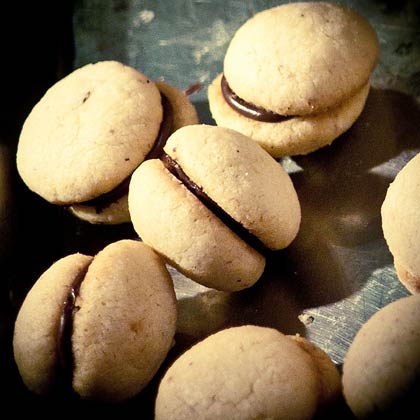
Baci di dama are found in Alessandria, especially near Tortona. They consist of two half spheres held together with a chocolate-and-almond cream. The dough is made of a mixture of ground almonds, flour, butter and liqueur.
Biscottini di Novara
Biscottini di Novara are fragile, feather-light sponge fingers made of flour, sugar and whole eggs. As the name indicates they are found in Novara and the surrounding area. They have an ancient history dating back to the 16th century when they were being made in convents.
Because they are light and spongy Biscottini di Novara are perfect dunked in passito wine at the end of a meal or for breakfast with a caffè e latte .
Bonet
The Piedmontese dessert par excellence, bonet is prepared similarly to a crème caramel, but with amaretto biscuits and cocoa. Etymologically the dessert takes it name from the mould used to prepare it, which used to be called bonèt ëd cusin (chef cap).
Canestrelli
Canestrelli are traditional ring-shaped, almond biscuits originally from the Monferrato area. They are either soft and dry or filled with chocolate cream. Their name means ‘little baskets’ because their shape reminds that of a small basket or ring. They are ideal with coffee, tea or sweet dessert wine.
Caramelle di Torino
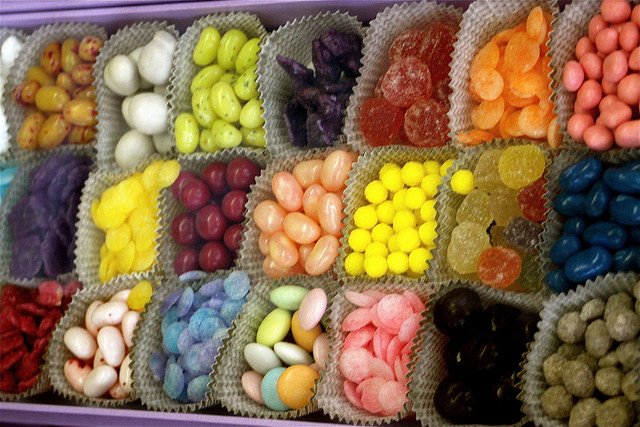
Turin is also famous for its colorful candy made from suger, fruit pastes and natural extracts. The multi-colored sugar candies were once known as bottoni da prete (priest’s buttons). Other typical candy includes those made from pineapples, strawberries, cherries, blueberries, lemons, aniseed and mint or other natural extracts.

Gianduiotto
One of the most famous chocolates of Turin, gianduiotti take their name from Gianduja, a mix of cocoa and the famous Tondo Gentile hazelnuts of Piedmont, of which they are made. They come as triangular-shaped delicacies, very smooth in consistency and individually wrapped in a gold-colored tinfoil cover.
Krumiri
Krumiri are a delicacy common in Casale Monferrato. They were invented by the confectioner Domenico Rossi in 1878, as a tribute to the first King of unified Italy, Vittorio Emanuele II of Savoy. The shape of the biscuit is thought to resemble the king’s extravagant handlebar moustache. The biscuits are made from wheat flour, sugar, butter, eggs and vanilla. They are eaten with tea or coffee or dunked in liqueur, sweet wine or zabaione.
Lingue di Gatto
These thin cookies resemble cats’ tongues, hence their name. They are made with flour, icing sugar, liquid cream, egg-whites and vanilla essence.
Marrons glacés of Cuneo
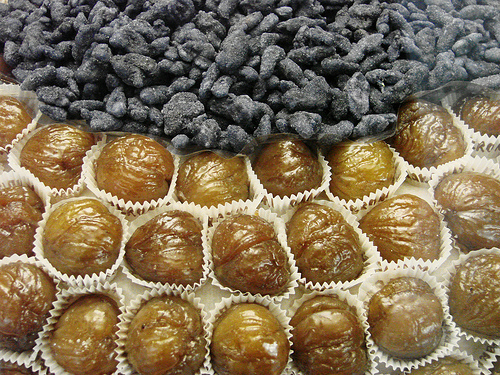
A marron glacé is a confection, consisting of a chestnut candied in sugar syrup and glazed. The preparation takes several days during with the chestnut is dipped into sirups with increasing sugar level. The operation is complicated by the fact that the chestnut may crumble during the process.
Italian has two words for chestnuts: castagna and marrone, the marrone being a type of castagna, but usually of higher quality. The chestnuts used to make marrons glacés usually come from the chestnut-growing areas North of Italy, such as Cuneo, which has been famous for centuries for its chestnuts.
The invention of the marron glacé is attributed to a chef who worked at the court of Carlo Emanuele I, Duke of Savoy (1562-1630). The recipe appears in the volume Confetturiere Piemontese on confectionery of the Piedmont region, printed in Turin in 1766, but a candied chestnut confection was already known around the beginning of the 15th century. The French expression ’marron glacé’ is much more common in Italy than the Italian term marroni canditi, which is not surprising as the court language of Savoy was French.
Marrons glacés can be consumed stand-alone or used as an ingredient for other desserts, such as gelato and semifreddo.
Nocciolini di Chivasso
These candies from Chivasso were invented in the 20th century. They are made with only three ingredients: toasted, ground Piedmontese hazelnuts, sugar and egg-whites.
Torcetti
Torcetti are ring-shaped biscuits made with natural yeast, flour, butter and sugar. Their name derives from their twisted dough. The dough is divided and rolled up by hand into long, thin, grissini-like sticks, which are dipped in the sugar. The sticks are divided into shorter pieces, of which the ends are pressed into rings before baking.
Torrone di Nocciole
Torrone is recognized as one of the Prodotti agroalimentari tradizionali italiani of several Italian regions. The Piedmontese Torrone is known as Torrone di Nocciole and consists of hazelnut nougat made of Piedmontese hazelnuts and locally produced honey.
Violette Candite

Candied violets are a specialty of Borgo San Dalmazzo, in the province of Cuneo. It are violet flowers, which have been immersed in hot syrup and left to dry until the sugar recrystallizes. In the Italian recipe the syrup is made without egg-white. The violets have to be in excellent condition with stems still attached. They are weighted and an equal weight of granulated sugar is dissolved into water to make the syrup.
You might also like:
Written on February 23, 2012, updated on November 6, 2013.
Photo credits (top to bottom): bonet piemontese by Rubber slippers in Italy; Confetteria Stratta © Slow Italy; Lingue di gatto by Ann@74.

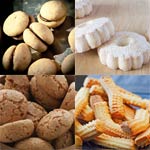
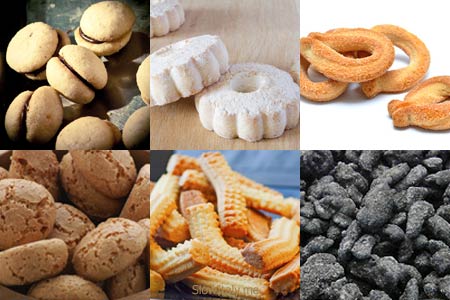

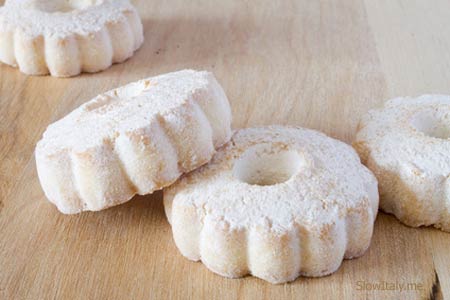
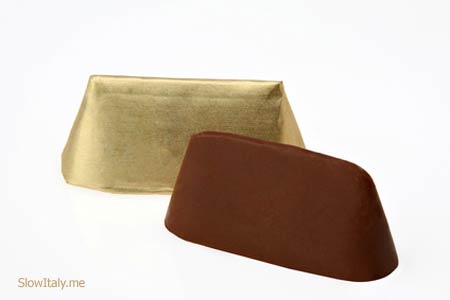
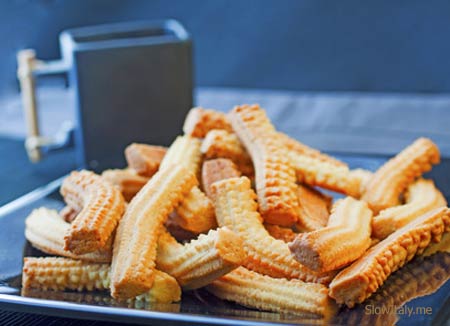

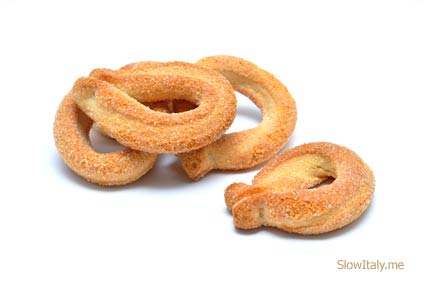
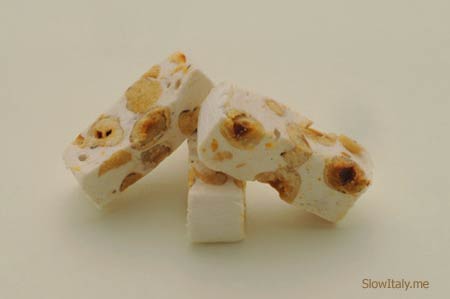




You might find some of the recipes on the internet, but the best thing, of course, is to taste the cookies and candies in one of the beautiful historic cafés and confectionery shops of Turin. 🙂